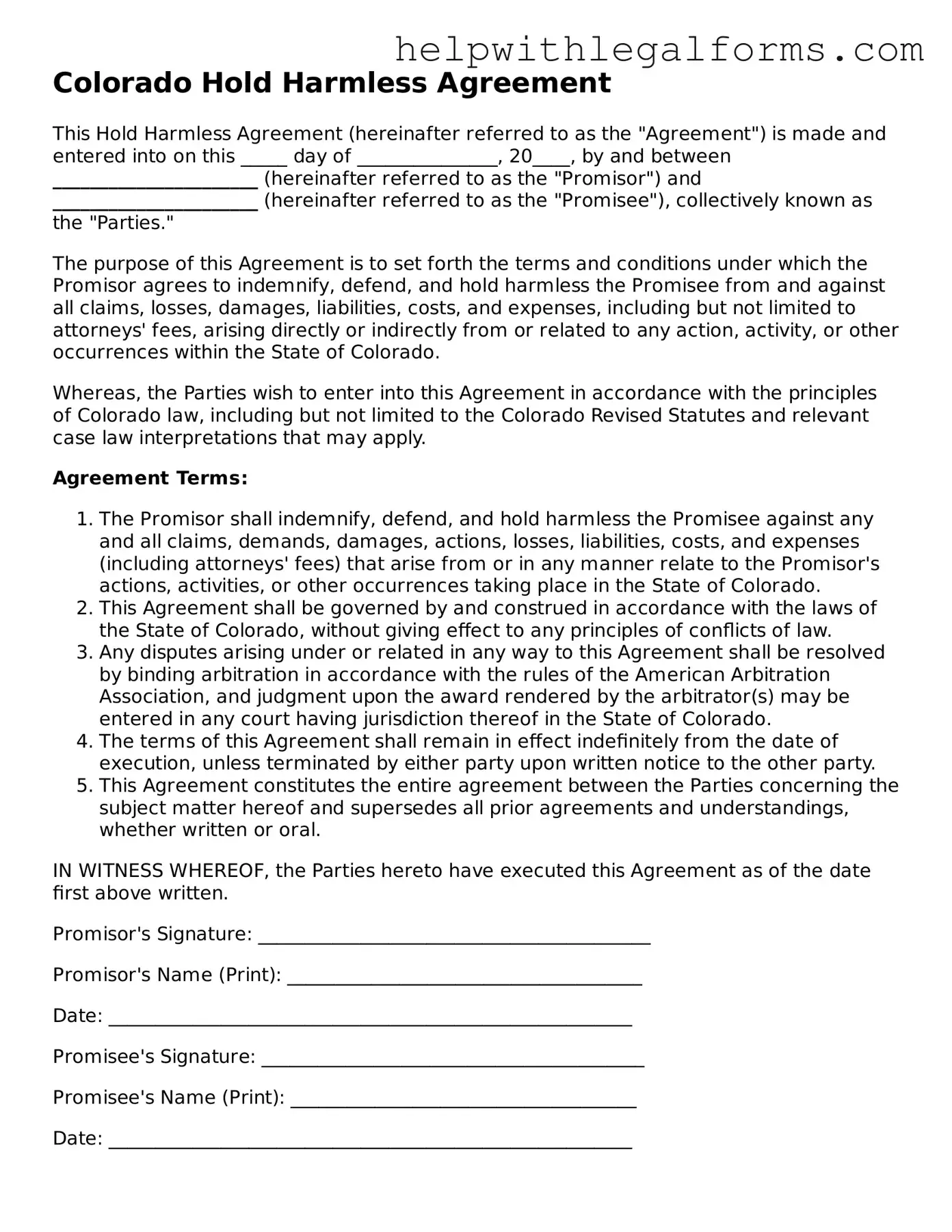What is a Hold Harmless Agreement in Colorado?
A Hold Harmless Agreement in Colorado is a legal document that individuals or entities use to protect themselves from legal liability. Essentially, it’s a form of agreement where one party agrees not to hold another party responsible for any risks, liabilities, or losses that might occur from a specific activity or event. This type of agreement is common in situations where risks are inherent, such as construction projects or special events.
Who can use a Hold Harmless Agreement?
Any individual or organization seeking to shield themselves from liability can use a Hold Harmless Agreement. This includes businesses, non-profits, contractors, property owners, and event organizers, among others. The agreement is versatile and can be tailored to fit the needs of various parties engaging in potentially risky activities.
What types of Hold Harmless Agreements are there?
There are generally three types of Hold Harmless Agreements: broad form, intermediate form, and limited form. The broad form agreement places all liabilities on the indemnified party, the intermediate form only covers liabilities resulting from the indemnitor's actions, and the limited form covers liabilities only related to the indemnitor's negligence. Each type tailors to different degrees of liability and risk management.
Is a Hold Harmless Agreement legally enforceable in Colorado?
Yes, a Hold Harmless Agreement is legally enforceable in Colorado, provided it meets certain criteria. The agreement must be clear, specific, and both parties must fully understand the terms. It cannot cover claims of willful misconduct or gross negligence. As with any contract, it's recommended to have the agreement reviewed by a legal professional to ensure enforceability.
Does the agreement need to be notarized to be valid in Colorado?
While notarization is not strictly required for a Hold Harmless Agreement to be valid in Colorado, having the document notarized can add an extra layer of authenticity and may prevent disputes about the agreement's legitimacy down the line. However, the primary factor for validity is the clear consent and understanding of both parties involved.
Can a Hold Harmless Agreement cover future claims?
Yes, a Hold Harmless Agreement can be designed to cover future claims, losses, or damages. This is particularly common in construction projects or ongoing services where potential risks may emerge over time. Clear language should be used to specify that the agreement's protection extends to future incidents to ensure enforceability.
What happens if a Hold Harmless Agreement is breached in Colorado?
If a Hold Harmless Agreement is breached in Colorado, the defaulting party may face legal action. The non-defaulting party can sue for damages resulting from the breach. The remedies available would depend on the specific terms of the agreement and the nature of the breach. Legal guidance is advisable to navigate the complexities of enforcing or disputing the agreement.
Can minors sign a Hold Harmless Agreement in Colorado?
Generally, minors (individuals under the age of 18) do not have the legal capacity to enter into binding contracts, including Hold Harmless Agreements, in Colorado. Agreements signed by minors can be considered void or voidable. If a minor is involved in an activity requiring such an agreement, a parent or legal guardian should sign on their behalf.
Are there any activities for which a Hold Harmless Agreement cannot be used in Colorado?
In Colorado, Hold Harmless Agreements cannot be used to indemnify individuals or entities against claims of willful misconduct or gross negligence. Furthermore, certain regulated activities might have specific legal constraints that limit the use of such agreements. It's essential to consult with a legal professional to understand the applicability of these agreements to specific scenarios.
How can one obtain a Hold Harmless Agreement form in Colorado?
Hold Harmless Agreement forms can be obtained through legal professionals or online legal document services. It is crucial, however, to ensure that any form used is compliant with Colorado laws and tailored to the specific situation. Professional legal advice can help adapt generic forms to meet the particular needs of the parties involved.
